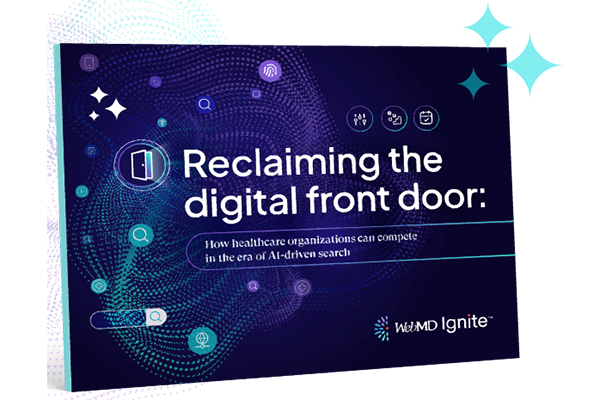Editor's Note: This blog was published prior to the transition to WebMD Ignite.
Social media has become an integral part of many healthcare organizations’ marketing and communications strategies. Across the United States, over 99 percent of hospitals have an active Facebook page – and an increasing number are also establishing a presence on platforms like Twitter and Instagram.
Social media is no longer optional. In order to engage with patients on the platforms they use the most, social networking and advertising are critical components of the overarching digital marketing strategy.
Let’s take a look at some of the benefits, challenges, and opportunities that social media presents in today’s healthcare landscape.
The benefits of social media in healthcare
Social media opens up many opportunities for health systems. It allows organizations to build connections, share discoveries, and develop credibility as thought leaders. Through platforms like Twitter and Facebook, physicians and health systems are able to share relevant health alerts, receive patient feedback, and bolster their brand with a focus on creating trust. By communicating with patients online, hospitals and physicians establish the foundation for a positive relationship. In addition to this, precisely targeted ads via social media platforms assist in personalized patient outreach.
According to a 2018 study, 80 percent of U.S. Internet users have searched for health information online, and 60 percent of social media users trust social media posts by doctors over any other group. By engaging and interacting on the social platforms that their patients frequent, health systems can revitalize their word-of-mouth referrals, improve communication, and provide better care by ensuring that patients continuously engage with the health system.
Challenges and risks of social media in healthcare
HIPAA compliance
HIPAA compliance is a paramount concern for all healthcare organizations, especially when it comes to social media. Specifically, health systems are hesitant that a published social media post may violate a patient’s privacy, or that social media may be another vulnerability for hackers or malware.
Fortunately for health systems, HIPAA has released a comprehensive list of social media guidelines that outline how to post information online without violating patient privacy. This primarily involves de-identifying patients by removing information like their name, date of birth, or insurance information. Keep in mind that hospitals can avoid HIPAA compliance concerns simply by getting the patient’s consent to be shared on social media.
Time constraints
Physicians are typically fully booked every day – if they do have some free time, then hospitals are often quick to assign them last-minute appointments. Already, physicians are only able to spend about 15 minutes with each of their patients, which leaves them little time in the day for relevant social media posts.
Marketing teams can help support physicians by drafting social posts that just need approval. Or, to generate more original content, health systems may want to offer incentives to physicians who post quality content to their social media accounts on a regular basis.
Professionalism
Maintaining an air of professionalism is a concern for the entire healthcare organization, but physicians are exceptionally cognizant of how they are perceived online. Physicians may be concerned that colleagues or patients will lose respect from them if they share inaccurate information, or fear that they may end up at the center of a controversy.
However, if all posts are appropriate and relevant, controversies are unlikely to occur. For additional guidance, healthcare professionals should adhere to The American College of Physicians and the Federation of State Medical Board’s guidelines for healthcare professionals in addition to all legal guidelines. If necessary, health systems should monitor all connected social media pages, and be ready to block or immediately resolve concerns with exceptionally negative users.
Healthcare social media tactics
Promote healthcare-specific networks
In this Internet-driven age, patients have a wealth of health and medical information at their fingertips: A quick Google search for rheumatoid arthritis, for instance, yields millions of results. In some cases, the best way to learn about coping with a health condition is by swapping stories and advice person-to-person on a forum.
One example of a patient-powered research network like this is PatientsLikeMe. Co-founders Jeff Cole and Ben and James Heywood set out to configure a way for patients to manage their own health conditions, changing the way the industry conducts research and improves patient care.
Cole and Heywood founded PatientsLikeMe based on the trial-and-error experience their brother went through during his fight with amyotrophic lateral sclerosis (ALS). They wanted to connect with patients coping with ALS and track how they handle their own day-to-day care. Today, with over 600,000 members, their network has grown to include patients with a diverse range of diseases and conditions.
These patient-powered platforms utilize the enormous reach of social media to connect target groups with one another – and with reputable, capable health systems. On these networks and forums, patients can explore care methods, learn from one another, and freely share their experiences with various medical conditions and health systems.
Live tweet to educate patients
A primary reason why healthcare organizations participate in social media is to help educate patients. They want to educate the public about innovative research and tips for staying healthy.
Frequent social media posting, like live-tweeting, provides numerous opportunities for education and engagement, boosts user authority and popularity, and works as a platform to showcase positive aspects of healthcare organizations.
Include hashtags to engage in conversations
To get the most out of their social media engagement efforts, we recommend leveraging relevant hashtags. Hashtags first became popular on Twitter, introduced as a way to link conversations and commentary on similar topics for simplified user search and popularity tracking. Today, hashtags are used on numerous social platforms – including Facebook, Instagram, LinkedIn, and others.
With the continuous flow and discovery of health information, hashtags offer both patients and physicians the ability to streamline their search across an entire social media platform. The utility of these hashtags is illustrated below by a volunteer organization, the Breast Cancer Social Media (#BSCM) Community. Using the hashtag, users can search #BSCM and access an entire world of support, guidance, and information – not just from fellow patients, but also the professional advice from clinicians and researchers.
To find hashtags that your health system can contribute to in a meaningful way, consult a hashtag database like Symplur. With this resource, healthcare organizations can find trending hashtags on conferences, diseases, research, and other generalized topics. This information can then be used to inspire social posts that reflect what patients are currently searching for.
Final thoughts
There’s no question that patients use the Internet to take control of their own health. Health systems need to step up their social media strategy to reach target audiences, boost patient engagement, and improve health outcomes. Although health systems must overcome challenges around privacy, time constraints, and professionalism, social media offers too many benefits for health systems to ignore.





